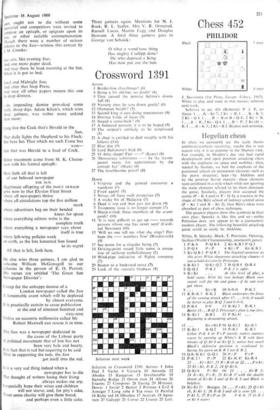Chess 452
PHILIDOR
J. Savournin (1st Prize, Europe Echecs, 1967). White to play and mate in two moves; solution next week.
Solution to no. 451 (Roberts): P x P, no threat. I K - Kt 7; 2 Kt x B. 1 K - K 3: 2 Kt-Q4.1...B x BorB-Q4; 2 Kt x B. 1 ...B x R; 2 Kt - Q 4. I —13 x P; 2 Kt (4) x B. 1 . . B - K 3; 2 Kt - B 2. Bizarre and amusing.
Hegelian chess
In chess we constantly sec the cycle thesis- antithesis-synthesis occurring; maybe this is one reason why it is so popular in the Marxist ussa. For example, in Morphy's day one had rapid development and open position attacking chess with the emphasis on space and mobility; then, started by Steinitz, we had the emphasis of the positional school on permanent elements such as the pawn structure; later-by Alekhinc and by the postwar Soviet masters - these elements were combined in a style which while not ignoring the static elements refused to let them dominate the game. Similarly, players first occupied the centre (P - K 4 and/or P - Q 4), a reaction in the shape of the Reti school of indirect control arose (P - Kt 3 and B - Kt 2), then Reti's ideas were absorbed as part of chess technique.
The greatest players show this synthesis in their own play; Spassky is like this and so - unlike Petrosian-does not appear to be a particularly modern player. The following beautiful attacking game could as easily be Alekhine.
White, B. Spassky. Black, T. Pctrosian. Opening, Sicilian (World Championship, nineteenth game). 1 P-K 4 P-Q B 4 2 Kt-K B 3 P-Q 3
3 P-Q 4 PxP 4 Kt xP Kt-K B 3
5 Kt-Q B 3 P-Q R 3 The Najdorf variation; as this gives White dangerous attacking chances it was a bold decision by Petrosian.
6 B-Kt 5 Q Kt-Q 2 7 B-Q B 4 Q-R 4 8 Q-Q 2 P-R 3 P-K 3 is safer.
9 B x Kt . . . At this level of play, a bokl move. With his two bishops Black now stands well for the end game - if he can ever get there.
Kt x B 10 0-0-0 P-K 3 11 K R-K I B-K 2 Black underrates the force
of the coming attack after 12 . . . it would be better to play B-Q 2 and 0-0-0.
12 P-B 4 0-0 13 B-Kt 3 R-K 1 Better 13 ...B-Q 2. Petrosian's plan is too slow.
14 K-Kt I B-B 1 15 P-Kt 4! ... Beginning a devastating attack.
15 . . . Kt x Kt P 16 Q-Kt 2 Kt-B 3 17 R-Kt 1 B-Q 2 18 P-B 5 K-R 1 Either P-K 4 or PxP merely makes 'natters worse by opening up White's K B with later threats of Q-Kt 6 or Kt-Q 5; notice how much Black's defensive position is weakened by having his pawn on K R 3 not K R 2.
19 QR-KB1 Q-Q 1 20 PxP PxP 21 P-K 5! P x P 22 Kt-K 4! Kt-R 4
22 . . . Kt x Kt?; 23 R x B ch or 22 ...PxKt;
23 Kt xKt, R-K 1; 24 Q-Kt 6.
23 Q-Kt 6 P x Kt Or 23 . . . Kt-B 5;
24 R x Kt, P x R; 25 Kt-B 31 with the double threat of Kt-Kt S and of Kt-K S and Black is helpless.
24 Kt-Kt 5! Resigns 24 ...PxKt; 25 QxKt ch, K-Kt 1; 16 R-B 3 and all is over (26 . . . P-Kt 5; 27 RxP or 26 . P-K 4: 27 Q-R 5 or Kt 8 mate)


































 Previous page
Previous page